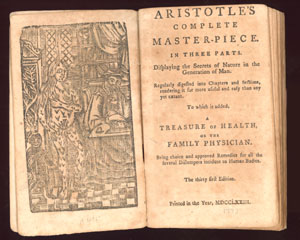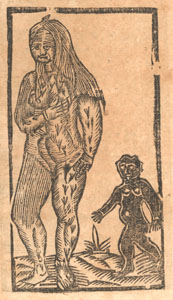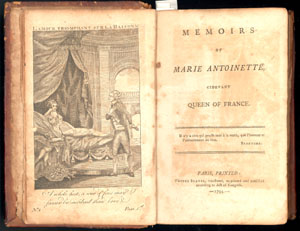

The underground trade in obscene, subversive, and blasphemous books in 18th century England was brisk (though perhaps not as brisk as on the Continent); but books like that were rare in America, and usually imported from overseas. Only one truly obscene book circulated widely in America, John Cleland’s Memoirs of a Woman of Pleasure, usually known by the name of its heroine as “Fanny Hill.” No American edition is known to have been published before the mid-19th century, though two or three editions were suppressed before their printing was complete. By and large the books sold under the counter in America were much tamer: ribald songs and stories, memoirs of adventurous foreigners, and strange books revealing the facts of life.
Aristotle’s Complete Master-Piece. 30th ed., London [i.e., Boston]: for Z. Feeling [i.e., Z. Fowle], 1766; and 31st ed., [U.S.], 1773.
These are probably the first two American editions of the most famous early modern sex manual, usually published with a false imprint and sold under the counter or by peddlers. The 1766 edition is the second recorded copy and the 1773 edition is unique. First published in England in 1684, it was supposed to be a medical guide for midwives, but the illustrations were prurient, and in fact demonstrate how images cause abnormal sexual arousal. They show monsters conceived while their parents were looking at pictures — in the case of the hairy maiden, a picture of John the Baptist (see back cover). By the same token the sight of the woman inspires Aristotle to write, and since this was the only illustration of a naked woman printed in colonial America, grotesque as it is, it surely aroused many a young man.
Jean-Pierre Camus. The Triumphs of Love. New York, 1792.
The only early American edition of this anthology of grotesque and sensational novellas. For example, in the first story a young woman can think of no other way to repel the advances of a nobleman than to lacerate her face with a pair of scissors. This sole surviving copy was inscribed by a woman.
The Golden Bull; or the Crafty Princess. Two copies, both [U.S., ca. 1800].
The Princess has to be crafty to escape the clutches of her evil father, who gives her the choice of marrying him or dying. She gets him to give her a life-size golden bull as a wedding present and then escapes from him by hiding inside it. For some reason the father sends the bull to the young man his daughter loves. He places it in his bedroom, the Princess pops out, and though he inexplicably fails to recognize her, they make love, and she crawls back inside the bull. She seems content to spend her days hiding in the bull and her nights in bed with her lover, until one day the young man’s sisters discover the Princess and conclude that he has been hiding a whore in his room. They try to murder her but somehow they fail and she ends up in a tree, etc., etc., and they live happily ever after. This surreal and faintly obscene poem was immensely popular in early America. These copies are both unique.
Pierre E. A. Goupil. Memoirs of Marie Antoinette. [New York], 1794; and [U.S.], 1794.
These Memoirs faithfully chronicle what the author calls the Queen’s “almost unequalled extreme of libidinous excesses.” Two editions were printed at the same time, one cheaper with small type and one crude woodcut bound in a paper wrapper, the other with larger type, bound in good-quality leather, with several expensive engravings of lewd episodes. Both editions were probably sold furtively, but the cheaper edition would have been better suited to a peddler’s trade, while the deluxe edition has a sophisticated, urbane feel.
Brothers of the Clergy. [U.S., ca. 1790] and … Priest and Deacon. [U.S., ca. 1790].
A Clergyman and his Deacon vie to see who has slept with more of the women of the parish. They agree that on a given Sunday whenever one of their partners enters the church, the Deacon will raise his arm and the Pastor will utter a “hem.” As the women pour in, the Deacon’s arm moves “like a saw-gate” and the Clergyman “cry’ hem, till well nigh throttl’.” Then the Clergyman’s wife comes in, and up goes the Deacon’s arm; so when the Deaconess enters, the Clergyman “with a vengeance fetch’ a hem …. Much as to say, Sir, we are even.” The Zinman Collection includes two editions of this bit of ribaldry, both of them the only known copies.
The Amours and adventures of two English gentlemen in Italy. Worcester: [I. Thomas], 1795.
These are gentlemen of the school of Don Juan and Casanova, who run grave risks and use devious stratagems in pursuit of the love of beautiful and cooperative women. Free sample: “Imagining he was her dear Lorenzo, she lay kindly pliant, and circling his body with a close embrace, gave him an entire enjoyment of all the sweets she had in store.” The publisher employed a deception of his own; he had the book bound in the distinctive coarse muslin usually reserved for elementary school books.




